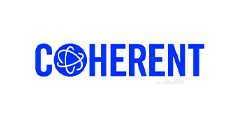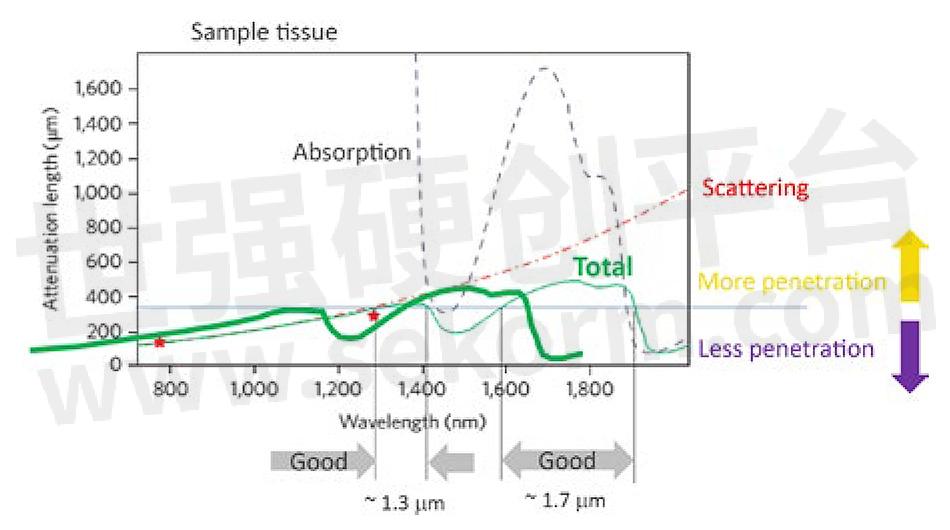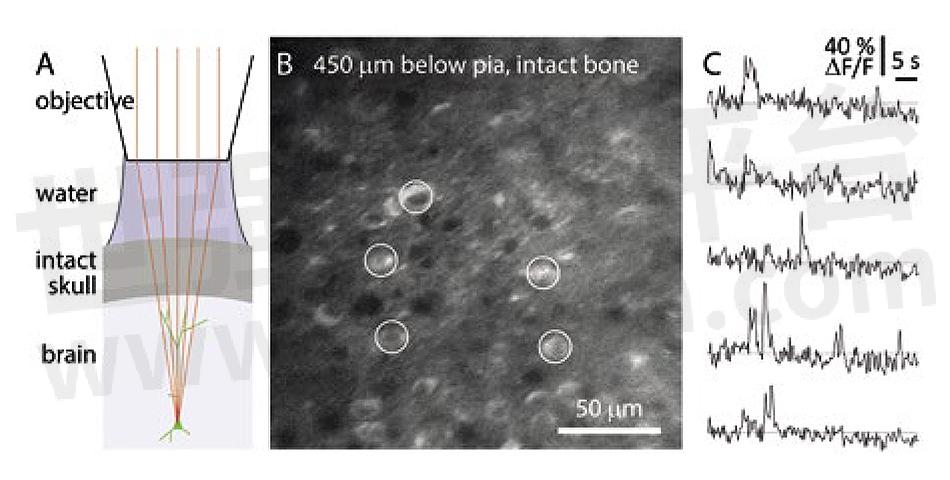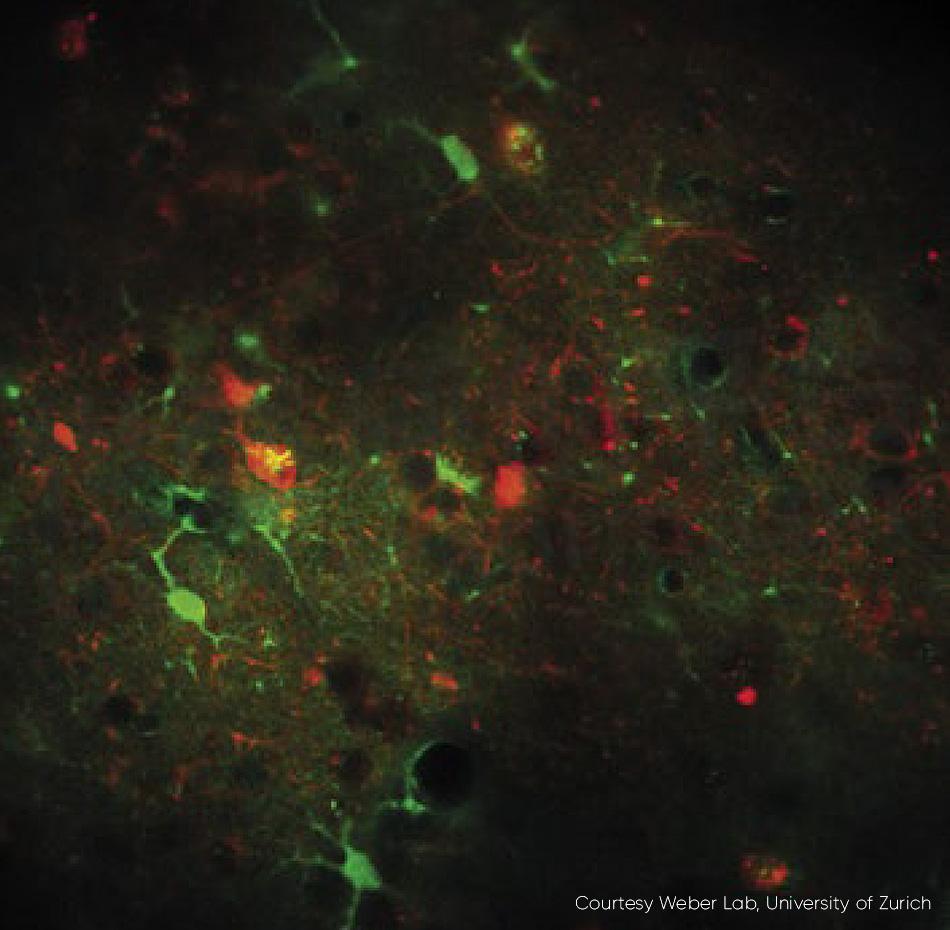Ytterbium Fiber Lasers Enable Cutting-Edge Neuroscience




Ultrafast Sources with New Capabilities and Enhanced Ease-of-use Features
Overview
Murine-based neuroscience research represents a major application segment for multiphoton microscopy. This article provides a glimpse into the field by examining a few interesting areas of investigation. As part of the quest toward understanding how cortical neuron networks operate well below the surface of brain tissue, red-shifted functional probes were developed; these are utilized in combination with deeper penetrating, long (i.e., > 1 micron) laser wavelengths. Recently, there is a growing interest in large-scale optogenetic photoactivation and three-photon excitation for ultra-deep images, both of which are photon-hungry. Titanium: Sapphire lasers cannot easily meet these needs, so laser manufacturers turned to ytterbium doped fiber laser engines, which offer several advantages, most notably power scaling and repetition rate agility.

Figure 1: The penetration depth for ultrafast lasers in live brain tissue is limited by a combination of scattering and absorption. There are two optimum penetration windows centered at 1300 and 1700 nm. Based on a private communication with Professor Chris Xu, Cornell University.
Ytterbium fiber lasers provide a fixed wavelength output at around 1040 nm, with tuning across the near infrared achieved with an optical parametric device. At the 80 MHz repetition rates typically used for two photon imaging, an optical parametric oscillator (OPO) is used within the laser head to provide broad wavelength tuning (660 nm to 1320 nm). This enables efficient two-photon excitation of both short wavelength and red-shifted fluorescent probes and proteins. An important additional advantage of this type of one-box source is that the user has access to two different output wavelengths: the fixed Yb output at 1040 nm and the tunable OPO output for optogenetic and other types of “dual wavelengths” experiments. Power is typically 1-3 W in each channel.
Unlike titanium:sapphire, ytterbium fiber is readily power scalable to create amplifiers with very flexible repetition rates (up to 10’s of MHz) that are well-suited for stimulation of larger neuron populations. Applications requiring high power and wavelength tuning, such as three-photon imaging, are then satisfied by adding an optical parametric amplifier (OPA). Several recent advances highlight the convergence of laser technology with the changing needs of the neuroscience community; a few are outlined below
Deeper 3-Photon Imaging
An overarching theme in neuroscience is imaging the full (>1 mm) depth of the mouse cortex, down to the hippocampus. There are two broad infrared “windows” where laser penetration and fluorescence signal retrieval are maximized: at 1.3 and 1.7 µm (fig. 1). Fortunately, the 1.3 µm window is ideal for three-photon excitation probes based on green fluorescent protein, and the 1.7 µm window is ideal for probes based on red fluorescent proteins, like Tdtomato. In addition, these wavelengths also penetrate reasonably well through thin bone, in some cases eliminating the need for a glass cranial window.
Three-photon imaging at these wavelengths is now enabled by ytterbium fiber amplifiers pumping a tunable optical parametric amplifier. With conventional OPAs, the internal architecture is optimized for either short pulses or broad wavelength tuning. But three-photon imaging ideally requires both. So, the latest OPAs designed for this application used a hybrid design, where a non-collinear stage generates the short pulses (compressible to 50-70 fs) followed by a collinear stage which delivers very broad wavelength tuning.
A team led by Jack Waters at the Allen Institute (Seattle, WA) have been using this type of amplifier plus OPA to perform three-photon imaging in this manner to observe how the mouse cortex processes neuromodulatory signals triggered by visual stimuli. The aim of Waters was to survey as much of the cortex as possible. The 1300 nm laser light transmits reasonably well through the mouse cranium so they don’t need a glass window and coold image over a large area of the cortex. Data from their studies are shown in figure 2.
Activity in Larger Neuron Populations
The maximum pulse repetition rate for this type of OPA is currently 2 MHz. But some applications are already needing even higher repetition rates, e.g., to monitor the signaling (via measuring the Ca2+ activity) of all the neurons in a target brain volume, or at least all the neurons in several viewing planes. Imaging larger neuron populations in real time inevitably requires faster scanning together with higher power to compensate for reduced dwell times.
A recent paper by Aliphasha Vaziri and collaborators at several US and Europeans Institutes has successfully demonstrated a novel way of achieving this type of large scale monitoring, while maintaining single neuron resolution [1]. They used 920 nm pulses to perform two-photon excitation of a common calcium indicator, GCAMP6m, with several clever innovations. They used a combination of temporal focusing (TeFo) and conventional focusing to match the focused beam waist to the typical dimensions of a single neuron. In order to monitor a large volume of neurons they elected to use smart scanning that targeted one laser pulse per voxel (i.e., one pulse per neuron). So, they needed high pulse energy. Also, these researchers wanted a pulse repetition rate higher than 4 MHz in order to reach a multihertz (3-160 Hz) viewing speed. Since OPAs have not yet reached this rate, they used an ytterbium fiber amplifier to pump a next-generation tunable ultrafast device called an optical parametric chirped pulse amplifier (OPCPA). This provides output speeds up to several MHz and is tuned by a clever chirp offset. This type of OPCPA is also now available as a single box product with the ytterbium fiber amplifier completely integrated with the compact head.

Figure 2: Allen Institute image of calcium imaging through intact mouse skull. (A) Schematic of preparation without acrylic or coverslip. (B) Temporal mean projection from a Emx1-IRES-Cre;- CaMk2a-tTA;Ai94 mouse. 10 Hz frame rate. 3P excitation at 1300 nm through intact skull, ~300 µm thick. Microscope focused 450 µm below pia. (C) Spontaneous calcium transients from GCaMP-expressing somata (circles in panel B). Excitation source: COHERENT (Monaco) amplifier with Coherent (Opera) OPA.

Figure 3: An example of fast frame rate calcium imaging. Neurons expressing RCaMP1.07 excited at 1040 nm, in vivo, mouse. Excitation source Chameleon Discovery TPC. Courtesy Weber Lab, University of Zurich.
Photo-activation of Larger Neuron Populations
Two-photon absorption of opsin proteins expressed in neurons (i.e., multiphoton optogenetics) is increasingly being used to perform activation and/or silencing of neurons at single neuron resolution. This can be combined with multi-photon calcium imaging to excite and monitor a network of neurons all at single neuron resolution – sometimes called “all optical physiology.” The original pioneer of optogenetics, Karl Deisseroth, is also at the forefront in developing two-photon optogenetic stimulation and silencing. His group at Stanford University are leaders in using two-photon excitation for this purpose.
Here again, the challenges are power and speed. However, the 1035 nm output of an ytterbium amplifier is a perfect match for two-photon excitation of short wavelength opsins, with no need for any type of tunable optical parametric device. And the high speed (0.4-50 MHz) supports even the fastest experiments. According to Jim Marshel from the Deisseroth lab, “10 MHz seems to be an optimum pulse rate that enables efficient photoactivation of tens and maybe hundreds of neurons in chronic, long-term studies. The high power and fast pulsing of the latest ytterbium fiber amplifiers is a good match for this application.”
Direct Laser Power Modulation
Advances in neuroscience are not only being supported by new amplifier materials and novel parametric device architectures for cutting edge studies, but existing mainstream two-photon imaging applications are also benefiting from new approaches to practical implementation. An example of this can be found in laser oscillators, where an important part of a complete multiphoton microscope is the technology to control the laser power upstream to the microscope scan head. This is a requirement for optimum performance in even simple raster-scanned experiments - laser power should be completely blocked as the microscope scan head returns the beam spot (fly-back) for the next y scan. It is also an important function for applications scanning large z stacks; as the system focuses deeper into the tissue, natural attenuation dictates the use of higher laser power to maintain constant image intensity. And in increasingly sophisticated high-speed scanning protocols, power control can be used to maintain the optimum power level relative to the voxel dwell time.
High speed power control has proved a challenge for both OEM microscope manufacturers and the large proportion of users who build their own multiphoton microscopes. Specifically, how to adjust the beam power in real time without unduly stretching (chirping) the pulse width or compromising the quality of the round, gaussian beam required for high resolution images.
The latest generation of ytterbium-based lasers now provides full independent control of both the tunable beam and the fixed wavelength beam, before they leave the laser head, i.e., with guaranteed pulse width and TEM00 beam quality (M2 < 1.1). Acousto-optic modulators (AOMs) can be utilized and externally controlled by a 0-10V analog input which is ideal for home-built microscopes, or via direct RF input to the AOMs to minimize cost and complexity for OEM microscope manufacturers. An application that benefits from high speed power modulation is fast frame rate calcium imaging (fig. 3).
Summary
Rapid developments in molecular probes and imaging methods, in synergy with complimentary advances in laser technology, are driving multiphoton microscopy to new heights of performance. Neuroscientists are exploiting these advances to increment the state-of-the-art for image resolution, depth, and functional capability, as they continue to unravel the mysteries of the brain.
Affiliations
1. Darryl McCoy, Coherent UK Ltd., Glasgow, UK
2. Marco Arrigoni, Coherent, Inc., Santa Clara, CA, USA
- |
- +1 赞 0
- 收藏
- 评论 0
本文由Ray转载自COHERENT Official Website,原文标题为:YTTERBIUM FIBER LASERS,本站所有转载文章系出于传递更多信息之目的,且明确注明来源,不希望被转载的媒体或个人可与我们联系,我们将立即进行删除处理。
相关推荐
Coherent‘s Laser Machines Bring Success to XL Precision Technologies
Medical device and component manufacturer XL-PT builds on strong growth by investing in more Coherent’s laser machines, bringing their count of StarCut Tube cutting machines to a total of six. The superior cutting of the Monaco femtosecond lasers in their newest StarCut Tube hybrid models has enabled XL-PT to significantly increase their nitinol work as well as eliminate most of the post-processing previously required with their stainless steel hypotubes.
Automated Laser Marking with Coherent CombiLine Laser Markers Delivers Production Flexibility for Dental Industry
Using several Coherent CombiLine laser markers enables dental equipment manufacturer Nichrominox to efficiently process diverse batches of parts. The CombiLine turnkey laser markers integrate the laser source, scanning, and beam delivery optics, and all the necessary control electronics and software into a standalone tool.
Coherent Monaco 30W紫外激光器可减小OLED形状切割热影响区,批量且经济地生产可靠折叠OLED显示屏
Coherent Monaco 30W 紫外激光器是进行高速、低热影响区 (HAZ) 形状切割的理想选择,用于批量且经济地生产可靠的折叠 OLED 显示屏。新型 Monaco 30 W 激光器采用整个 Monaco 系列中配备的专有、超可靠的长寿命三倍频技术。该技术可实现 10,000 多小时正常运行,无需客户干预。
CM97-1000-76PM 976nm微型蝶形激光二极管泵浦模块,具有FBG和PM光纤光电器件
描述- 该资料介绍了Coherent公司生产的976 nm MINI-BUTTERFLY激光二极管泵浦模块(型号CM97-1000-76PM),这是一种用于工业脉冲光纤预放大器和掺铒光纤放大器(EDFA)激光应用的波长稳定的高功率单模激光二极管模块。该模块具有高输出功率、极化保持单模光纤、内部热电冷却器和监控二极管等特点。
型号- CM97-1000-76PM
CM97A1064NFBG脉冲1064nm窄带FBG高功率微型蝶形激光二极管模块光电器件
描述- 该资料介绍了Coherent公司生产的CM97A1064NFBG脉冲窄带光纤激光二极管模块。这款模块专为脉冲窄带光纤激光器和直接频率转换应用设计,具有高功率、波长稳定等特点。
型号- CM97A1064NFBG
多光子成像:新一代光纤激光器将尖端性能与24/7工业可靠性相结合
描述- 本白皮书介绍了基于钇光纤技术的超快激光器在多光子成像领域的应用。这些激光器结合了高性能与工业级可靠性,适用于最新的多光子成像和光遗传学激活技术。文中讨论了对更高功率和更长波长的需求,并阐述了钇掺杂光纤技术在解决这些问题上的优势。此外,还详细介绍了Coherent公司推出的几种新型激光产品,包括Fidelity-2、Fidelity-HP、Chameleon Discovery和Monaco/Opera-F系列,它们分别针对不同的应用场景提供不同级别的功率和波长调谐能力。文章强调了这些激光器的工业级可靠性、易用性、低成本和高性能特点,以及其在神经科学和其他研究领域的重要性。
带光束管理的FL-ARM高功率可调环形模式(ARM)光纤激光器
描述- 该资料介绍了HighLight FL-ARM系列工业多千瓦光纤激光器,具备独特的ARM技术,提供两种独立可控的同轴光束。这些激光器适用于多种焊接任务,如锌涂层钢的无间隙焊接和铝焊接(无需填充材料),具有低飞溅和无热裂纹的特点。产品特点包括可调功率范围、高稳定性、先进的闭环功率控制和优化的编程工具。
型号- FL7500-ARM,FL4000-ARM,FL-ARM,FL8000-ARM,FL-ARM SERIES,FL2000-ARM,FL6000-ARM,FL10000-ARM
Coherent Introduces Industry-first Pump Laser Diode with Record 65W Power
Coherent Corp, a leader in high-power semiconductor lasers, announced the introduction of its next-generation pump laser diode, with 65W of output power for fiber lasers in industrial and consumer applications.
Coherent Introduces High-Power Laser Sensor PM10K+ that Speeds Measurements by 500%
Coherent Corp. announces the launch of its next-generation high-power laser sensor designed to support the expanding high-power applications market and reduce measurement times by up to 500%.
MLU96A1060CWG脉冲1060nm SLD型高功率非制冷3引脚微型激光二极管模块光电器件
描述- 该资料介绍了Coherent公司生产的MLU96A1060CWG脉冲1060纳米单模高功率无冷却3针微型格式激光二极管模块。该模块专为脉冲光纤激光器设计,具有紧凑的3针小型封装,提供高达1瓦特的峰值输出功率,波长为1060纳米,光谱宽度大于10纳米,适用于光纤激光器和传感领域。
型号- MLU96A1060CWG
CM97A1064BFBG脉冲1064nm超宽带FBG高功率微型蝶形激光二极管模块光电器件
描述- 该资料介绍了Coherent公司生产的CM97A1064BFBG脉冲1064纳米宽带光纤激光二极管模块。这款模块专为脉冲光纤激光应用设计,具有高功率、波长稳定性和超宽频带发射等特点。
型号- CM97A1064BFBG
Coherent Introduces the Industry’s First Commercially Available 50W Pump Laser Diodes for Fiber Lasers
The new laser diodes from Coherent achieve 50 W of output power, 40% more than that of the existing product, enabling high-power industrial fiber laser designs with fewer pump laser diodes.
亮点FL-ARM紧凑型高功率可调环形模式(ARM)光纤激光器
描述- 该资料介绍了HighLight FL-ARM Compact系列工业级多千瓦光纤激光器。这些激光器适用于各种挑战性的焊接任务,具有可调节的环形模式(ARM),提供两种配置:多模版本和优越亮度版本。它们具备高功率输出、优异稳定性、高效焊接过程和高品质焊缝等特点。
型号- FL-ARM,FL5000C-ARM,FL8000C-ARM,FL6000C-ARM,FL10000C-ARM,FL2000C-ARM,FL4000C-ARM,FL7500C-ARM
CM97A1064脉冲1064nm高功率微型蝶形激光二极管模块光电器件
描述- 该资料介绍了Coherent公司生产的CM97A1064型号的高功率单模激光二极管模块。这款模块专为脉冲光纤激光器和需要1064nm单模光的连续波(CW)应用设计,具有高稳定性的输出功率和紧凑的微型蝴蝶型封装。
型号- CM 97A1064,CM97A1064
电子商城
品牌:COHERENT
品类:Single-Stage Thermoelectric Module
价格:¥138.0250
现货: 1,250
品牌:COHERENT
品类:Single-Stage Thermoelectric Module
价格:¥745.0191
现货: 600
品牌:COHERENT
品类:Single‐Stage Thermoelectric Module
价格:¥192.4021
现货: 524
品牌:COHERENT
品类:Single‐Stage Thermoelectric Module
价格:¥252.6552
现货: 518
品牌:COHERENT
品类:Single-Stage Thermoelectric Cooler
价格:¥1,971.8640
现货: 508
品牌:COHERENT
品类:Single-Stage Thermoelectric Module
价格:¥488.7889
现货: 500
品牌:COHERENT
品类:Single-Stage Thermoelectric Module
价格:¥107.1444
现货: 486
品牌:COHERENT
品类:Single-Stage Thermoelectric Module
价格:¥432.0068
现货: 475
品牌:COHERENT
品类:Single-Stage Thermoelectric Module
价格:¥485.0000
现货: 460
现货市场



























































































































































































登录 | 立即注册
提交评论